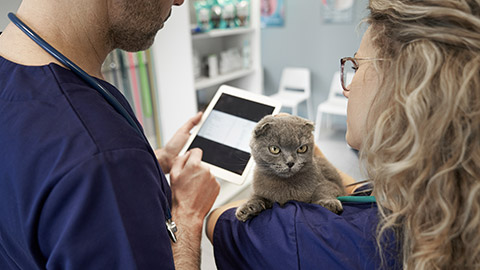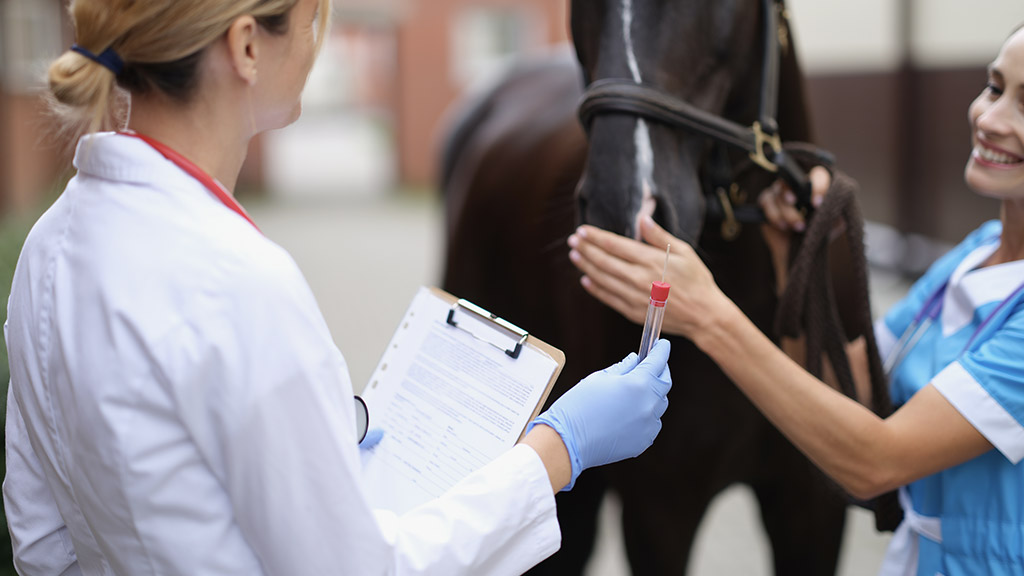The animal care industry is highly regulated, and accurate and careful documentation is required. The animal and human medical worlds have quite a lot in common, especially where documentation is concerned. It is important to become aware of industry documentation. As you progress through your career, you will become familiar with and make contributions to industry documentation requirements.
What sort of paperwork is required in your job?
There are quite a few forms that require filling out regarding animal care. Some of them are official government or business forms that need to be accurately completed and lodged with the relevant agency or organisation, and others are our internal forms to document things like client records, animal identification, treatment procedures and dietary intake. It is important that we complete this paperwork accurately, legibly, and promptly and store it appropriately. The documentation should be stored in a relevant filing system either by hard copy or electronically and remain confidential.
Internal Documentation
- Client Records
- Treatment
- Procedures
- Policies and Procedure
External Documentation
- Government forms
- Laws
- Regulations
- Audits
Types of Documentation you may encounter
In the animal care industry, documentation is essential for ensuring the health, safety, and well-being of animals, as well as
maintaining compliance with regulations and providing clear communication among staff. Here are some common types of documentation used in animal care:
- Animal Health Records
- Medical History: Detailed records of each animal’s medical history, including vaccinations, surgeries, treatments, and any chronic conditions.
- Veterinary Reports: Documentation of veterinary visits, diagnoses, prescribed medications, and treatment plans.
- Health Monitoring Logs: Regular entries tracking the animal’s vital signs, weight, appetite, behavior, and overall health.
- Intake and Adoption Records
- Intake Forms: Documents used when an animal is first brought into the facility, including information on the animal’s background, reason for surrender, and initial health assessment.
- Adoption Contracts: Legal agreements outlining the terms and conditions of adopting an animal, including the adopter’s responsibilities.
- Behavioural Assessments: Evaluations conducted to assess an animal’s temperament and suitability for adoption.
- Daily Care Logs
- Feeding Schedules: Documentation of each animal’s feeding times, amounts, and types of food provided.
- Exercise Logs: Records of physical activities, walks, or playtime for each animal.
- Cleaning and Maintenance Logs: Documentation of cage or kennel cleaning, bedding changes, and general maintenance tasks.
- Incident Reports
- Accident/Injury Reports: Detailed records of any accidents, injuries, or bites involving animals or staff, including the circumstances and actions taken.
- Behavioral Incident Reports: Documentation of any significant behavioural issues, such as aggression or escape attempts, and how they were managed.
- Lost/Found Animal Reports: Records of any animals that go missing or are found, including descriptions, identification details, and recovery actions.
- Compliance and Regulatory Documentation
- Licenses and Permits: Documentation of the facility’s operating licenses, permits for handling certain species, and compliance with local regulations.
- Inspection Reports: Records of health and safety inspections conducted by regulatory bodies, along with any corrective actions taken.
- Medication Logs: Document all medications administered to animals, including dosages, times, and staff responsible.
- Training and Behavioral Documentation
- Training Logs: Records of training sessions for animals, including the methods used, progress made, and goals achieved.
- Behavioural Modification Plans: Detailed plans for addressing specific behavioural issues, including techniques and timelines.
- Socialisation Records: Documentation of interactions between animals and staff or other animals to track socialization progress.
- Communication and Management Records
- Staff Communication Logs: Records of shift changes, updates, and any important information that needs to be communicated between staff members.
- Meeting Minutes: Documentation of team meetings, including topics discussed, decisions made, and action items assigned.
- Visitor Logs: Records of any visitors to the facility, including volunteers, potential adopters, and external contractors.
- Financial and Inventory Documentation
- Expense Reports: Documentation of costs associated with animal care, including food, medical supplies, and facility maintenance.
- Inventory Logs: Records of supplies on hand, such as food, cleaning products, and medical equipment, to ensure proper stock levels.
- Donation Records: Documentation of financial or in-kind donations received, including donor information and how the donations are used.

Each workplace, from early childhood to construction, has policies and procedures. Animal care is no different. Policies and procedures are carefully developed documents that have been written in accordance with regulations specific to the industry. There are policies and procedures in place for virtually any type of situation, from privacy and confidentiality to communication. It is important you familiarise yourself with the workplace’s policies and procedures they have in place. When you are first employed, you will likely receive a staff handout book during your induction, which will be taken through the workplace policies and procedures. These documents will be there for you to refer to at any time when you need additional clarification.
Depending on your animal care service, there will be various policies and procedures that you may need to familiarise yourself with prior to commencing work and making sure you are aware of any changes or updates that may occur internally (review cycle) and externally (updates to laws and regulations).
Below is a list of policies and procedures you may encounter in your role working with animals in various animal care settings.
1. Animal Admission and Intake Policy
- Procedure for New Admissions: Steps for admitting new animals, including health assessments and documentation requirements.
- Quarantine Procedures: Guidelines for isolating new or sick animals to prevent the spread of disease.
2. Animal Health and Medical Care Policy
- Vaccination and Preventive Care: Requirements for routine vaccinations, deworming, and other preventive care measures.
- Medication Administration: Procedures for prescribing, storing, and administering medications to animals.
3. Animal Behavior and Handling Policy
- Handling Aggressive Animals: Guidelines for safely handling animals that display aggressive or fearful behaviour.
- Behavioural Assessment Procedures: Steps for evaluating animal behaviour and determining suitability for adoption or further training.
- Training and Enrichment Programs: Procedures for implementing behavioural training and enrichment activities.
4. Animal Welfare and Ethics Policy
- Humane Treatment Standards: Guidelines to ensure all animals are treated humanely, with respect and care.
- Euthanasia Policy: Criteria and procedures for humane euthanasia, including consent and documentation requirements.
- Animal Rights and Protection: Commitment to adhering to laws and regulations regarding animal welfare and protection.
5. Client Interaction and Communication Policy
- Client Confidentiality: Guidelines for maintaining the privacy of client information and animal medical records.
- Appointment Scheduling Procedures: Steps for booking, rescheduling, and managing client appointments.
- Customer Service Standards: Expectations for interacting with clients, including handling complaints and providing information.
6. Facility and Equipment Maintenance Policy
- Cleaning and Sanitation Procedures: Daily, weekly, and monthly cleaning schedules for cages, kennels, and common areas.
- Equipment Maintenance and Safety: Guidelines for the regular inspection, cleaning, and maintenance of medical and care equipment.
- Waste Disposal Protocols: Procedures for the proper disposal of biological and hazardous waste.
7. Staff Training and Development Policy
- Onboarding and Training: Procedures for training new staff on clinic policies, animal care, and safety protocols.
- Continuing Education: Requirements for ongoing staff education and training to keep skills and knowledge up to date.
- Performance Review Process: Guidelines for regular staff evaluations and feedback sessions.
8. Safety and Emergency Preparedness Policy
- Fire and Evacuation Procedures: Steps for safely evacuating animals and staff in case of fire or other emergencies.
- First Aid Protocols: Procedures for administering first aid to animals and staff in case of injury.
- Infectious Disease Control: Guidelines for managing outbreaks of contagious diseases within the clinic.
9. Record Keeping and Documentation Policy
- Medical Records Management: Procedures for creating, maintaining, and archiving animal medical records.
- Inventory Control Procedures: Steps for tracking and managing clinic inventory, including medications, food, and supplies.
- Incident Reporting: Guidelines for documenting and reporting any accidents, injuries, or unusual incidents.
10. Financial Management and Billing Policy
- Billing and Payment Procedures: Guidelines for invoicing clients, accepting payments, and managing outstanding accounts.
- Financial Record Keeping: Procedures for maintaining accurate financial records and compliance with tax regulations.
- Donation and Fundraising Policy: Guidelines for managing and documenting donations and fundraising activities.
11. Volunteer and Internship Program Policy
- Volunteer Onboarding: Procedures for recruiting, training, and managing volunteers at the clinic.
- Internship Program Guidelines: Expectations and requirements for interns, including duties and supervision.
- Volunteer Safety and Conduct: Guidelines for ensuring the safety and proper conduct of volunteers while working with animals.
12. Adoption and Rehoming Policy
- Adoption Screening Procedures: Steps for evaluating potential adopters to ensure suitable homes for animals.
- Adoption Contracts and Agreements: Legal agreements outlining the terms of adoption, including return policies.
- Post-Adoption Follow-Up: Guidelines for follow-up communications with adopters to ensure the well-being of rehomed animals.
Case Study
Happy Paws Animal Care
Please see an example of policies and procedures below:
Animal Admission and Intake Policy |
| Purpose: To ensure that all animals admitted to the facility receive thorough health assessments and proper documentation and are safely integrated into the facility. This policy outlines the steps for admitting new animals and the procedures for isolating new or sick animals to prevent the spread of disease. |
|
Scope: |
Procedure for New Admissions |
| Step 1: Initial Assessment |
|
| Step 2: Documentation and Records |
|
| Step 3: Housing and Initial Care |
|
| Step 4: Communication |
|
Quarantine Procedures |
| Purpose: To prevent the spread of infectious diseases within the facility by isolating new or sick animals until they are deemed healthy and safe for integration with the general population. |
| Step 1: Identification of Quarantine Candidates |
|
| Step 2: Quarantine Area Setup |
|
| Step 3: Care and Monitoring in Quarantine |
|
| Step 4: Cleaning and Sanitation |
|
| Step 5: Release from Quarantine |
|
Now, in relation to workplace communication is a very important component of reception skills and workplace communication.
Some policies that you may encounter to help guide you with communication with internal and external stakeholders include the following:
Workplace Communication
1. Workplace Health and Safety (WHS) Communication
- Open and Transparent Communication: Staff must communicate hazards, risks, and incidents immediately to ensure safety for both humans and animals. Reporting systems may be in place for incidents, accidents, or near misses.
- Clear Instructions: Clear communication regarding the handling of animals, especially in stressful or dangerous situations (e.g., dealing with aggressive or injured animals), is crucial for safety.
- Documentation of Procedures: Written policies around animal handling, cleaning, and feeding are regularly updated and need to be communicated effectively across teams.
2. Code of Conduct and Professionalism
- Respectful Interaction: Communication between staff, clients, and suppliers must be polite, respectful, and considerate. This involves treating colleagues and customers with empathy and maintaining a supportive atmosphere.
- Confidentiality: Maintaining confidentiality about customer information (e.g., pet medical history) is essential and must be communicated as a key part of company policy.
3. Client Communication
- Clear Client Instructions: Staff are required to provide clear, jargon-free instructions to clients about their pets' care, including feeding, exercise, medication, and post-treatment instructions.
- Customer Feedback and Complaints Handling: Procedures for addressing customer feedback, concerns, or complaints are standardized, requiring staff to follow certain protocols for escalation and resolution while keeping clients informed.
4. Team Communication and Collaboration
- Daily Briefings and Handovers: Many animal care facilities use scheduled briefings or handovers (verbal or written) to communicate essential information between shifts, ensuring continuity in animal care.
- Conflict Resolution: Conflict resolution procedures encourage open dialogue to resolve misunderstandings or disagreements within the team. Clear channels for reporting and resolving issues without escalation are typically provided.
- Diversity and Inclusion: Communication policies often emphasize inclusivity, ensuring that all team members, regardless of background, are heard and respected. Training in cultural competency may also be included.
5. Technology and Record-Keeping
- Use of Communication Tools: Email, instant messaging, and specialized animal care software (for booking, medical records, etc.) are used for internal and client communication. Procedures govern the proper use of these tools, ensuring records are maintained securely and efficiently.
- Incident Reporting Systems: Digital systems for reporting injuries, emergencies, or animal health issues often require staff to follow specific communication protocols, ensuring timely action and appropriate documentation.
6. Training and Continuous Improvement
-
Ongoing Staff Training: Regular training in communication skills (e.g., customer service, conflict resolution, clear reporting) is typically provided. These trainings emphasize the need for continuous communication learning to keep up with industry best practices.
- Feedback Mechanisms: Staff are encouraged to provide and receive constructive feedback, fostering a communicative work environment where improvements are continually made.
These policies and procedures aim to create an efficient, safe, and respectful workplace while ensuring the highest standard of care for animals and satisfaction for clients.
Resolving Conflict
Organisational policies and procedures in the animal care industry, as in other workplaces, typically include clear guidelines for resolving conflicts between staff members in a respectful and professional manner. These guidelines ensure that any disputes are handled constructively, minimizing disruptions to work and maintaining a positive, collaborative environment. Key aspects of these policies may include:
1. Conflict Resolution Policy
- Respectful Communication: Staff are encouraged to communicate respectfully at all times, even during disagreements. Personal attacks, derogatory language, and unprofessional behaviour are prohibited.
- Active Listening: Staff are trained to actively listen to each other’s concerns without interrupting or dismissing their perspectives. Acknowledging and understanding different viewpoints is crucial in resolving conflicts.
- Direct Resolution: Team members are often encouraged to resolve minor conflicts directly with the person involved through calm, constructive discussion. This helps address issues before they escalate.
2. Escalation Process
- Mediation by Supervisors or Managers: If the conflict cannot be resolved directly between staff members, the policy usually stipulates that the issue be escalated to a supervisor or manager. The manager may act as a neutral mediator, facilitating open discussion and ensuring both parties feel heard.
- Formal Grievance Procedure: If the conflict remains unresolved after mediation, staff members can formally lodge a grievance, which triggers a more structured investigation and resolution process. The formal process often involves HR or higher management.
3. Documentation
- Incident Reporting: Conflicts that escalate or involve serious issues (such as bullying, harassment, or discrimination) may require formal reporting through an incident report. Clear documentation ensures transparency and helps in resolving issues fairly.
- Follow-Up Procedures: After conflicts are resolved, the policies may require a follow-up with the involved parties to ensure the resolution is maintained and that no further issues arise.
4. Confidentiality
- Private Discussions: All discussions regarding conflicts are typically handled privately and confidentially to protect the dignity of all parties involved. This prevents unnecessary spreading of the issue and allows for a fair, unbiased resolution process.
5. No Retaliation
- Protection from Retaliation: Policies often explicitly state that staff members involved in a conflict will not face retaliation for raising concerns or engaging in the conflict resolution process. This encourages employees to come forward without fear of negative consequences.
6. Training and Development
- Conflict Management Training: Staff may receive training in conflict resolution techniques, such as negotiation, de-escalation, and effective communication strategies. This equips employees to handle conflicts constructively when they arise.
- Emotional Intelligence: Some organizations provide training in emotional intelligence, which helps staff manage their emotions, recognise others' emotions, and engage in empathetic, non-confrontational communication.
7. Team Collaboration and Support
-
Team Building Activities: Regular team-building exercises and fostering a supportive work culture are often part of the policy to prevent conflicts. Strengthening team relationships and promoting collaboration reduces the likelihood of disputes.
- Open-Door Policy: Many organizations encourage an open-door policy, where staff feel comfortable approaching management at any time to discuss concerns before conflicts occur.
8. Zero-tolerance for Harassment and Bullying
- Clear Stance on Harassment and Bullying: Many workplace communication policies explicitly outline zero tolerance for bullying, harassment, and discrimination. This includes guidelines on how to report such behaviours and the consequences for those found in violation of these policies.
By following these procedures, animal care organisations promote a positive work environment where conflicts are addressed quickly, respectfully, and professionally, minimising the impact on operations and ensuring the well-being of both staff and animals.

Record keeping is a form of written communication, specifically the maintenance of information that will likely be referred to at a later date.
In an animal care environment, you may be responsible for maintaining workplace records such as:
- client records
- treatment and medication notes/logs
- animal identification records
- dietary information
- training/socialisation/exercise details
- stock control
- financial records
- hygiene processes, to name a few.
The more experience you obtain, the more familiar you will become with these workplace records and how they are used and filed. Records are important documents that often need to be kept for several years.
Best Practice for Record-Keeping
Effective record-keeping is crucial in the animal care industry to ensure high standards of care, legal compliance, and efficient facility management. By adhering to best practices and maintaining thorough documentation, animal care facilities can provide the best possible outcomes for the animals in their care.
- Consistency: Ensure that all records are updated regularly and consistently by the staff responsible for specific tasks.
- Accuracy: Double-check entries for accuracy, especially when recording medical treatments, medications, and incident reports.
- Confidentiality: Maintain the confidentiality of client information and sensitive animal health data, only sharing it with authorized personnel.
- Organisation: Use a standardized system for organising records, whether paper-based or digital, to facilitate easy retrieval and review.
- Training: Provide regular training to staff on proper record-keeping practices, emphasising the importance of thorough and accurate documentation.
- Backups: Ensure that all digital records are regularly backed up to prevent data loss and that paper records are stored securely.
Digital VS Paper Record
- Digital
- Advantages
- easy to update, search and share
- reduces physical storage space
- often includes built-in reminders or treatment.
- Disadvantages:
- requires reliable software and hardware
- potential for data breaches if not properly secured.
- Advantages
- Paper
- Advantages
- no need for technology
- can be easier for some staff to update on the go.
- Disadvantages
- requires significant physical storage space
- harder to search and organize
- at risk of damage or loss.
- Advantages
Types of Records you may encounter or required to help maintain/manage
Animal Health Records
- Medical History:
- Detailed records of each animal's medical history, including vaccinations, surgeries, treatments, and any chronic conditions.
- Documentation of any medical procedures performed, such as spaying/neutering, dental work, or wound treatment.
- Vaccination Records:
- Records of all vaccinations administered, including dates, types of vaccines, and the next scheduled vaccinations.
- Medication Administration:
- Logs of all medications given to an animal, including dosage, frequency, and the administering staff member's name.
- Health Monitoring Logs:
- Daily or periodic logs track an animal's vital signs, weight, appetite, behaviour, and overall health status.
Intake and Adoption Records
- Intake Forms:
- Documents that capture essential information when an animal is first brought into the facility, such as species, age, gender, and initial health assessment.
- Behavioural Assessments:
- Records evaluate the animal's temperament, socialisation, and behavioural issues.
- Adoption Contracts:
- Legal agreements outlining the terms and conditions of an adoption, including the adopter’s responsibilities and any follow-up requirements.
Daily Care Logs
- Feeding Records:
- Documentation of feeding schedules, types of food provided, and any changes in diet.
- Exercise Logs:
- Records of the animal's physical activities, including walks, playtime, and other forms of exercise.
- Cleaning and Maintenance Logs:
- Logs documenting the cleaning of cages, kennels, and other living spaces, as well as any facility maintenance performed.
Incident and Safety Reports
- Incident/Injury Reports:
- Detailed accounts of any accidents or injuries involving animals or staff, including the circumstances and actions taken.
- Behavioral Incident Reports:
- Documentation of any significant behavioural incidents, such as aggression or escape attempts, and how they were managed.
- Lost/Found Animal Reports:
- Records of animals that go missing or are found, including descriptions, identification details, and recovery actions
Compliance and Regulatory Documentation
- Licenses and Permits:
- Documentation of the facility’s operating licenses and permits, as well as compliance with local, state, and federal regulations.
- Inspection Reports:
- Records of health and safety inspections conducted by regulatory bodies, along with any required corrective actions.
- Quarantine Logs:
- Documentation of animals placed in quarantine, including the reason for quarantine, duration, and health monitoring.
Financial and Inventory Logs
- Billing and Payment Records:
- Documentation of services provided, fees charged, payments received, and any outstanding balances.
- Inventory Logs:
- Records of supplies on hand, such as food, medications, and cleaning products, to ensure proper stock levels.
- Donation and Fundraising Records:
- Documentation of donations received, including donor information, amounts, and how the donations were used.
Training and Staff Records
- Staff Training Logs:
- Records of training sessions attended by staff, including dates, topics covered, and any certifications earned.
- Volunteer Records:
- Documentation of volunteer activities, hours worked, and any training or orientations completed.

As you would probably imagine, there are specific record-keeping guidelines that need to be considered to ensure they remain confidential and legible.
The following are guidelines for record-keeping and should always be observed.
- Handwrite legibly if using paper-based documents and complete accurate data entry when using computers.
- Include your name and signature where applicable.
- Make sure your date is correct and, if necessary, timestamp the record.
- Be mindful of your language, remember the records may be shown to members of the public someday, avoid abbreviations if you can, and never write any insulting comments.
- Be objective and focus on facts, not speculation.
- Do not erase information that has previously been recorded; if an amendment is required, cross out the older entry with a single line (so that it can still be read by others if need be) and write the new information next to it. Initial and potentially date the change.
- Respect privacy. If personal details are provided, inform people if you need to share details with any third parties.
- Save / store records in a secure location such as a database with login/password requirements or a locked filing cabinet.
